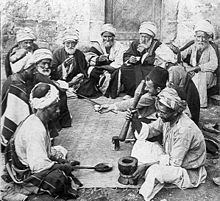
The public sphere (German: Öffentlichkeit) is an area in social life where individuals can come together to freely discuss and identify societal problems, and through that discussion influence political action. A "Public" is "of or concerning the people as a whole." Such a discussion is called public debate and is defined as the expression of views on matters that are of concern to the public—often, but not always, with opposing or diverging views being expressed by participants in the discussion.[1] Public debate takes place mostly through the mass media, but also at meetings or through social media, academic publications and government policy documents.[2]
The term was originally coined by German philosopher Jürgen Habermas who defined the public sphere as "made up of private people gathered together as a public and articulating the needs of society with the state".[3] Communication scholar Gerard A. Hauser defines it as "a discursive space in which individuals and groups associate to discuss matters of mutual interest and, where possible, to reach a common judgment about them".[4] The public sphere can be seen as "a theater in modern societies in which political participation is enacted through the medium of talk"[5] and "a realm of social life in which public opinion can be formed".[6]
- ^ Wessler, Hartmut; Freudenthaler, Rainer; Wessler, Hartmut; Freudenthaler, Rainer (2011). "Public Sphere". Communication. doi:10.1093/obo/9780199756841-0030.
- ^ Overland, Indra (2018-01-01). Public Brainpower: Civil Society and Natural Resource Management. pp. 1–22.
- ^ Soules, Marshall. "Jürgen Habermas and the Public Sphere". Media Studies.ca.
- ^ Gerard A. Hauser (1999). Vernacular Voices: The Rhetoric of Publics and Public Spheres. Univ of South Carolina Press. pp. 61–. ISBN 978-1-57003-310-0. OCLC 1022680271.; a similar formulation is found in: Hauser, Gerard A. (June 1998), "Vernacular Dialogue and the Rhetoricality of Public Opinion", Communication Monographs, 65 (3): 83–107, doi:10.1080/03637759809376439, ISSN 0363-7751., p. 86. See also: G. T. Goodnight (1982). "The Personal, Technical, and Public Spheres of Argument". Journal of the American Forensics Association. 18:214–227.
- ^ Fraser, Nancy (1990), "Rethinking the Public Sphere: A Contribution to the Critique of Actually Existing Democracy", Social Text, 25 (26): 56–80, doi:10.2307/466240, JSTOR 466240, S2CID 9589555. Also published in 1992 in Fraser, Nancy (1992), "Rethinking the Public Sphere: A Contribution to the Critique of Actually Existing Democracy", in Calhoun, Craig (ed.), Habermas and the Public Sphere, Cambridge Mass.: MIT press, pp. 109–142, ISBN 978-0-262-53114-6
- ^ Asen, Robert (1999). "Toward a Normative Conception of Difference in Public Deliberation". Argumentation and Advocacy. 25 (Winter): 115–129. doi:10.1080/00028533.1999.11951626.